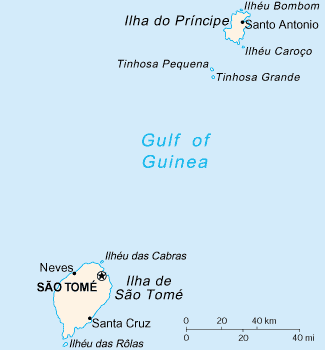
Geography of São Tomé and Príncipe
Background Information
This content from Wikipedia has been selected by SOS Children for suitability in schools around the world. Do you want to know about sponsoring? See www.sponsorachild.org.uk
São Tomé and Príncipe is a small nation composed of an archipelago located in the Gulf of Guinea of equatorial Atlantic Ocean. The nation's main islands are São Tomé and Príncipe, for which the country is named. These are located about 300 and 250 km (186 and 155 mi), respectively, off the northwest coast of Gabon in West Africa. The nation's geographic coordinates are a latitude of 1°00′N and a longitude of 7°00′E.
São Tomé and Príncipe constitute one of Africa's smallest countries. They have a total of 209 km (130 mi) of coastline. Both are part of an extinct volcanic mountain range, which also includes the island of Bioko in Equatorial Guinea to the north and Mount Cameroon to the west. São Tomé is 48 km (30 mi) long and 32 km (20 mi) wide and the more mountainous of the two islands. Its peaks reach 2,024 m (6,640 ft). Principe is about 16 km (10 mi) long and 6 km (4 mi) wide, making it the smaller of the two. This makes the total land area of the country 1,001 km2 (386.5 sq mi), about five times the size of Washington, D.C. Both islands are crossed by swift streams radiating down the mountains through lush forest and cropland to the sea.
The highest point is Pico de São Tomé, at 2,024 m (6,640 ft).
Climate
At sea level, the climate is tropical—hot and humid with average yearly temperatures of about 27 °C (80.6 °F) and little daily variation. At the interior's higher altitudes, the average yearly temperature is 20 °C (68 °F), and nights are generally cool. Annual rainfall varies from 5,000 mm (196.9 in) on the southwestern slopes to 1,000 mm (39.4 in) in the northern lowlands. The rainy season runs from October to May.
Statistics
Maritime claims:
-
- Measured from claimed archipelagic baselines
- Exclusive economic zone: 200 nmi (370.4 km; 230.2 mi)
- Territorial sea: 12 nmi (22.2 km; 13.8 mi)
- Climate
- Tropical; hot, humid; one rainy season (October to May)
- Terrain
- Volcanic, mountainous
- Elevation extremes
-
- Lowest point: Atlantic Ocean 0 m (0 ft)
- Highest point: Pico de São Tomé 2,024 m (6,640 ft)
- Northernmost Point : northern Príncipe Island
- Southernmost Point : Ilhéu das Rolas
- Westernmost Point : Lembá SW or Neves
- Easternmost Point : eastern Príncipe Island east of Santo António
- Natural resources
- Fish, hydropower
- Natural hazards
- NA
- Environment--current issues
- Deforestation; soil erosion and exhaustion
- Environment--international agreements
-
- Party to: Biodiversity, Climate Change, Desertification, Environmental Modification, Law of the Sea, Ship Pollution
- Signed, but not ratified: None of the selected agreements


